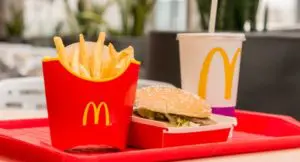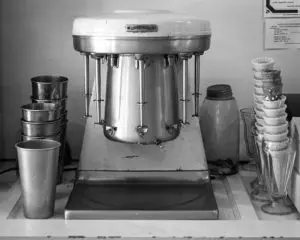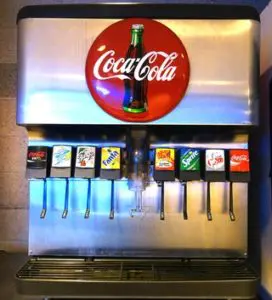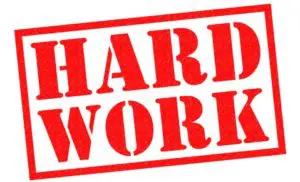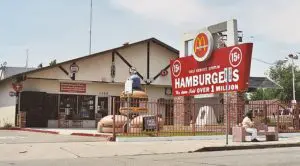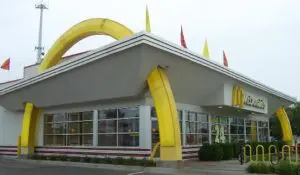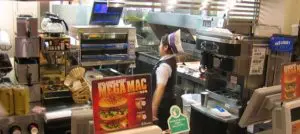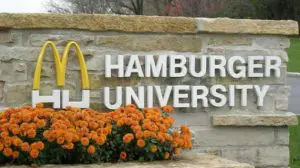I was an overnight success all right, but thirty years is a long, long night.
In Grinding It Out,Ray Kroc tells the story of how he created McDonald’s. Kroc launched the company in 1954 when he was 52 years old. Twenty-two years later McDonald’s topped one billion in total revenue.
(Photo by Ruslan Gilmanshin)
CHAPTER 1
Kroc spent seventeen years selling paper cups before he discovered a five-spindled milk-shake machine called the Multimixer. Kroc:
It wasn’t easy to give up security and a well-paying job to strike out on my own… I plunged gleefully into my campaign to sell a Multimixer to every drug store soda fountain and dairy bar in the nation. It was a rewarding struggle. I loved it. Yet I was alert to other opportunities.
(Multimixer, Photo by Visitor7, via Wikimedia Commons)
Kroc began to hear about the McDonald brothers. They had not just one Multimixer. Nor just two or three. They had eight Multimixers. This peaked Kroc’s curiosity, so he went to look at the McDonald brothers’ operation in San Bernardino, California.
At first, Kroc wasn’t impressed. But then he saw all the helpers arriving and setting up. Soon they were moving really fast. And flocks of people were in line getting hamburgers. Each hamburger was only 15 cents, and there was almost no wait between the customer placing an order and the order being filled.
Kroc spoke with several customers and learned that they just loved the food. Kroc was captivated by the system. He asked the McDonald brothers to join him for dinner, which they did:
I was fascinated by the simplicity and effectiveness of the system they described that night. Each step in producing the limited menu was stripped down to its essence and accomplished with a minimum of effort. They sold hamburgers and cheeseburgers only. The burgers were a tenth of a pound of meat, all fried the same way, for fifteen cents. You got a slice of cheese on it for four cents more. Soft drinks were ten cents, sixteen-ounce milk shakes were twenty cents, and coffee was a nickel.
The McDonald brothers showed Kroc the design of a new drive-in building. It was red and white with touches of yellow. There was a set of arches that went through the roof. There was also a tall sign out front with arches illuminated by neon tubes.
Kroc’s excitement grew:
That night in my motel room I did a lot of heavy thinking about what I’d seen during the day. Visions of McDonald’s restaurants dotting crossroads all over the country paraded through my brain. In each store, of course, were eight Multimixers whirring away and paddling a steady flow of cash into my pockets.
The next day, Kroc returned to see the operation in action again. He paid particular attention to how the french fries were made. McDonald’s french fries were outstanding and a key to the store’s success. Kroc observed carefully and thought that he had memorized the process for making terrific french fries. Kroc admits this was a mistake because he missed a few things.
Kroc met with Mac and Dick McDonald again. This time, Kroc asked them why they didn’t expand into a chain. The brothers demurred. When pressed, they pointed to their house on a hill. They said they were leading a peaceful existence and didn’t want any more problems. Eventually, Kroc said that he himself could open up the new locations.
CHAPTER 2
Kroc:
When I flew back to Chicago that fateful day in 1954, I had a freshly signed contract with the McDonald brothers in my briefcase. I was a battle-scared veteran of the business wars, but I was still eager to go into action. I was 52 years old. I had diabetes and incipient arthritis. I had lost my gall bladder and most of my thyroid gland in earlier campaigns. But I was convinced the best was ahead of me. I was still green and growing, and I was flying along at an altitude slightly higher than a plane.
Kroc recounts that he was born in Oak Park, just west of Chicago, in 1902. Kroc’s parents were of Czech origin – Bohemians, as Ray says. His father, Louis Kroc, had gone to work for Western Union at age twelve and had worked his way up. Ray Kroc’s mother, Rose, was “a loving soul.” She gave piano lessons to make extra money.
(Czech Republic on map with flag pin, Photo by Sjankauskas)
Ray Kroc’s brother, Bob, became a professor and medical researcher, but Ray wasn’t much interested in school. Ray wasn’t even interested in reading books:
I was never much of a reader when I was a boy. Books bored me. I liked action. But I spent a lot of time thinking about things. I’d imagine all kinds of situations and how I would handle them.
…
They called me Danny Dreamer a lot, even later when I was in high school and would come home all excited about some scheme I’d thought up. I never considered my dreams wasted energy; they were invariably linked to some form of action. When I dreamed about having a lemonade stand, for example, it wasn’t long before I set up a lemonade stand. I worked hard at it, and I sold a lot of lemonade. I worked at a grocery store one summer when I was still in grammar school. I worked at my uncle’s drug store. I worked in a tiny music store I’d started with two friends. I worked at something whenever possible. Work is the meat in the hamburger of life. There is an old saying thatall work and no play makes Jack a dull boy. I never believed it because, for me, work was play. I got as much pleasure out of it as I did from playing baseball.
Kroc went with his father to see many Chicago Cubs games. The Cubs were contenders then.
Kroc enjoyed working for his uncle Earl Edmund Sweet’s drug store soda fountain in Oak Park.
That was where I learned that you could influence people with a smile and enthusiasm and sell them a sundae when what they’d come for was a cup of coffee.
Kroc learned to play the piano well. He thought he could make money as a piano man. He ended up going into the music store business with two friends. But it didn’t really work.
Though Kroc didn’t like school–one reason being that the progress felt much too slow–there was one school activity he did like: debating.
When World War I came, Kroc got a job selling coffee beans and novelties door-to-door. He thought he wouldn’t need to go back to school. Soon Kroc felt he should be a part of the war effort. Kroc:
My parents objected strenuously, but I finally talked them into letting me join up as a Red Cross ambulance driver. I had to lie about my age, of course, but even my grandmother could accept that. In my company, which assembled in Connecticut for training, was another fellow who had lied about his age to get in. He was regarded as a strange duck, because whenever we had time off and went out on the town to chase girls, he stayed in camp drawing pictures. His name was Walt Disney.
Kroc writes that he wanted to be a salesman, and also to play the piano. For a time, he sold novelty ribbons. Kroc was doing well:
In 1919 anyone making twenty-five or thirty dollars a week was doing well, and it wasn’t long before–on good weeks with a lot of musical jobs–I was making more money than my father.
Kroc had several jobs as a piano man, including playing in a band at Paw-Paw Lake, Michigan. That’s where he met his first wife, Ethel Flemming, of Scottish background.
Kroc continues:
My next job was in Chicago’s financial district as a board marker on the New York Curb, as the market that became the American Stock Exchange used to be called. My employer was a firm named Wooster-Thomas. A substantial sound to that, I thought. My job was to read the ticker tape and translate the symbols from it into prices that I posted on the blackboard for the scrutiny of the gentlemen who frequented our office. I later learned that the impressive-sounding name fronted a bucket-shop operation that was selling watered stock all over the place.
A bit later, Kroc got a job selling Lily brand paper cups.
CHAPTER 3
Kroc was selling Lily paper cups from early in the morning until 5:00 or 5:30pm. He says he would have worked longer, but he had a job playing piano at radio station WGES in Oak Park. Kroc worked at WGES 6pm to 8pm, and then 10pm to 2am. Kroc:
I was driven by ambition. I hated to be idle for a minute.
(Photo of paper cups by Fedoseeva Galina)
Kroc again:
My cup sales kept growing as I learned how to plan my work and work my plan. My confidence grew at the same rate. I found that my customers appreciated a straightforward approach. They would buy if I made my pitch and asked for their order without a lot of beating around the bush. Too many salesmen, I found, would make a good presentation and convince the client, but they couldn’t recognize that critical moment when they should have stopped talking. If I ever notice my prospect starting to fidget, glancing at his watch or looking out the window or shuffling the papers on his desk, I would stop talking right then and ask for his order.
Winter of 1924 was tough for the paper cup business. Kroc notes that one reason he didn’t do well was because he put the customer first:
My philosophy was one of helping my customer, and if I couldn’t sell him by helping him improve his own sales, I felt I wasn’t doing my job.
Kroc started doing well in the paper cup business. But knowing how things slowed down in the winter, Kroc took a 5-month leave of absence. He got a job in Fort Lauderdale, Florida, selling real estate for W. F. Morang & Son. Kroc quickly became a top salesman.
The property was underwater, but there was a solid bed of coral rock beneath, and the dredging for the intercoastal raised all the lots high and dry, with permanent abutments. People who purchased those lots really got a bargain, even though the prices were astronomical for those times, because the area is now one of the most beautiful in all of Florida, and lots there are worth many times what they sold for then.
Of course, there were many lots sold at that time that didn’t turn out to be good investments at all. There was a great deal of chicanery. After a crackdown, Kroc got a job playing piano before returning to Chicago.
CHAPTER 4
From 1927 to 1937, Kroc focused entirely on selling paper cups. The paper container industry was undergoing several changes. But then the stock market crashed in 1929, which ushered in the Great Depression. Kroc’s father, who had been successfully speculating in real estate, was hit hard.
In 1930, Kroc saw an opportunity at the soda fountains in Walgreen’s Drug Company.
(Soda fountain, Photo by Bigapplestock)
At Walgreen’s, customers could buy sodas “to go.” Kroc tried to convince the food service man for Walgreen’s, a man named McNamarra. No go. But then Kroc got McNamarra to try it for one month using free cups.
Finally he agreed. I brought him the cups, and we set the thing up at one end of the soda fountain. It was a big success from the first day. It wasn’t long before McNamarra was more excited about the idea of takeouts than I was. We went in to see Fred Stoll, the Walgreen purchasing agent, and set up what was to be a highly satisfactory arrangement for both of us. The best part of it for me personally was that every time I saw a new Walgreen’s store going up it meant new business. This sort of multiplication was clearly the way to go. I spent less and less time chasing pushcart vendors around the West Side and more time cultivating large accounts where big turnover would automatically winch in sales in the thousands and hundreds of thousands. I went after Beatrice Creamery, Swift, Armour, and big plants with in-factory food service systems such as U.S. Steel.
Soon Kroc had roughly fifteen salesmen working for him.
I loved to see one of these young fellows catch hold and grow in his job. It was the most rewarding thing I’d ever experienced.
Kroc counselled his salesmen to sell themselves first, which would make it easier to sell paper cups.
Kroc mentions one of his customers, Ralph Sullivan in Battle Creek, Michican, who invented a new way to make milk shakes:
Ralph had come up with the idea of reducing butterfat content in a milk shake by making it with frozen milk. The traditional method of making a shake was to put eight ounces of milk into a metal container, drop in two small scoops of ice cream, add flavoring, and put the concoction onto a spindle mixer. Ralph’s formula was to take regular milk, add a stabilizer, sugar, corn starch, and a bit of vanilla flavoring and freeze it. The result was ice milk. He would put four ounces of milk into a metal container, drop in four scoops of this ice milk, and finish it off in the traditional way. The result was a much colder, much more viscous drink, and people loved it. The lines around his store in the summertime were nothing less than amazing. This ice milk shake had a lot of advantages over regular milk shakes. Instead of being a thin, semicool drink, it was thick and very cold.
The Multimixer was a piece of equipment that could make five milk shakes at once. It was a game changer. Kroc ended up leaving the paper cup business in order to sell Multimixers. Kroc formed a partnership with the inventor of the Multimixer, Earl Prince.
CHAPTER 5
Kroc encountered a great deal of adversity in his life, especially when he was trying to sell Multimixers.
For me, this was the first phase of grinding it out– building my personal monument to capitalism. I paid tribute… for many years before I was able to rise with McDonald’s on the foundation I had laid. Perhaps without that adversity I might not have been able to persevere later on when my financial burdens were redoubled.
(Illustration by Chris Dorney)
Kroc successfully marketed Multimixers at restaurant and dairy association conventions. Soon Kroc was so busy that he had to hire a bookkeeper. Partly by luck, he found Mrs. June Martino. She was warm and compassionate, but also focused and able. June studied electronics at Northwestern University. Because higher mathematics was difficult for her, she had a tutor. She was determined and “no challenge was too big for her,” notes Kroc.
CHAPTER 6
In Southern California in the early 1930s, the drive-in restaurant came into existence. Mac and Dick McDonald were New Englanders who moved to Southern California to work on movies. At one point, they ran their own movie theatre. Sometimes they only ate on meal a day in order to save money. They would have a hot dog from a nearby stand.
Dick McDonald later recalled that he and his brother noticed that the hot dog stand was the only business doing well then. That probably gave the brothers the idea of launching a drive-in restaurant.
The McDonald brothers’ first restaurant in San Bernardino was doing a great deal of business, but it still wasn’t very profitable. Kroc:
So they did a courageous thing. They closed that successful restaurant in 1948 and reopened it a short time later with a radically different kind of operation. It was a restaurant stripped down to the minimum in service and menu, the prototype for legions of fast-food units that later would spread across the land. Hamburgers, fries, and beverages were prepared on an assembly line basis, and, to the amazement of everyone, Mac and Dick included, the thing worked! Of course, the simplicity of the procedure allowed the McDonalds to concentrate on quality in every step, and that was the trick.
(Original McDonald’s fast food restaurant, Photo by Cogart Strangehill, via Wikimedia Commons)
Kroc reached an agreement with the McDonald brothers. Kroc would be able to franchise copies of McDonald’s everywhere in the United States. He admits he made a mistake in the contract with the McDonalds: any changes to Kroc’s units would have to be put in writing, signed by both brothers, and sent by registered mail. The McDonalds had an affable openness and Kroc trusted them. But there would be problems later.
The agreement stipulated that Kroc would receive 1.9 percent of gross sales from franchisees. Of that, 0.5 percent would go to the McDonald brothers. Kroc also could charge an initial franchise fee of $950 for each license.
Making great french fries was essential:
…I had explained to Ed MacLuckie with great pride the McDonald’s secret for making french fries. I showed him how to peel the potatoes, leaving just a bit of the skin to add flavor. Then I cut them into shoestring strips and dumped them into a sink of cold water. The ritual captivated me. I rolled my sleeves to the elbows and, after scrubbing down in proper hospital fashion, I immersed my arms and gently stirred the potatoes until the water went white with starch. Then I rinsed them thoroughly and put them into a basket for deep frying in fresh oil.
The only trouble was that, after following this process, the french fries tasted like mush. Something had gone wrong or there was a missing step. Eventually Kroc learned that potatoes taste better if they’re allowed to dry out. (Without knowing it, the McDonald brothers had been letting their potatoes dry in the desert breeze.) It took Kroc and associates three months before they perfected the process of making french fries.
Kroc’s first store was in a mediocre location, but it did well. Many of Kroc’s golfing friends from Rolling Green became successful McDonald’s operators.
Kroc frequently helped prepare a McDonald’s for opening. He didn’t mind mopping or cleaning the restrooms, even if he was in his suit.
CHAPTER 7
Harry Sonneborn resigned as vice-president of Tastee-Freeze and sold all his stock because he wanted to work in Ray Kroc’s organization. Sonneborn had noticed how exceptionally well a McDonald’s restaurant nearby was doing. Kroc told him that McDonald’s couldn’t afford to hire him. However, the company needed the help and Harry was persistent. McDonald’s ended up hiring him.
Kroc envisioned Sonneborn dealing with finance, June Martino running the office, and he himself managing operations and new development. Kroc, Sonneborn, and Martino worked extremely hard, but it was also fun:
We were breaking new ground, and we had to make a lot of fundamental decisions that we live with for years to come. This is the most joyous kind of executive experience. It’s thrilling to see your creation grow.
(Old style McDonald’s, Photo by Wahkeenah, via Wikimedia Commons)
Kroc writes that one fundamental decision he made was that the corporation would not be a supplier for its operators. Kroc explains:
My belief was that I had to help the individual operator succeed in every way I could. His success would ensure my success. But I couldn’t do that and, at the same time, treat him as a customer. There is a basic conflict in trying to treat a man as a partner on the one hand while selling him something at a profit on the other. Once you get into the supply business, you become more concerned about what you are making on sales to your franchisee than with how his sales are doing… Our method enabled us to build a sophisticated system of purchasing that allows the operator to get his supplies at rock-bottom prices.
Opening new locations was slow and painful work. Kroc describes what they were trying to build:
We wanted to build a restaurant system that would be known for food of consistently high quality and uniform methods of preparation.
(Photo by Ben Garney, via Wikimedia Commons)
Kroc and associates also realized that McDonald’s should go into the restaurant development business. The idea came from Harry Sonneborn. They started Franchise Realty Corporation with $1,000 paid-in capital. Harry turned that into $170 million worth of real estate. The idea was to get a property owner to lease his land on a subordinated basis. Kroc observes:
This was the beginning of real income for McDonald’s. Harry devised a formula for the monthly payments being made by our operators that paid our own mortgage and other expenses plus a profit. We received this monthly minimum or a percentage of the volume the operator did, whichever was greater.
Harry succeeded in getting life insurance companies to invest, which gave McDonald’s the capital they needed to keep growing rapidly.
Kroc notes the gratitude he felt toward Harry Sonneborn and June Martino:
…June later told me that all the while her two boys were growing up, she never made it to one of their birthday parties or graduation ceremonies, and there were several times that she had to be in the office on Christmas. I knew what she and Harry were doing, because I was in the same boat… I couldn’t give them raises to compensate them for their past efforts, but I could make sure that they would be rewarded when McDonald’s became one of the country’s major companies, which I never doubted it would. I gave them stock – ten percent to June and twenty percent to Harry – and ultimately it would make them rich.
CHAPTER 8
Fred Turner was a terrific worker and natural leader, says Kroc. At first, Turner was going to be a franchisee. To get experience, he started out as a worker in an already established McDonald’s. But Kroc realized that Turner should be in charge of corporate operations. Turner started at headquarters in January 1957. The company opened twenty-five new locations that year, and Turner was involved in every one.
Also involved in each opening in 1957 was Jim Schindler, a stainless-steel supplier from Leitner Equipment Company. At June’s suggestion, Kroc hired Schindler. Kroc had to pay him $12,000 a year, more than Harry, June, or Ray himself was getting. Kroc remarks that Schindler might not have come on board for that salary had he not had a Bohemian background like Kroc.
Kroc comments on a difference between Sonneborn and himself:
Harry was the scholarly type. He analyzed situations on the basis of management theory and economic principles. I proceeded on the strength of my salesman’s instinct and my subjective assessment of people.
(Illustration by Airdone)
Although he wasn’t perfect, Kroc excelled at picking the right people, which was central to McDonald’s success. But Kroc couldn’t explain exactly how he did it.
Sonneborn and Kroc complemented each other in many ways. And Fred Turner added another dimension. For instance, the hamburger bun was an object of close attention for McDonald’s. Fred Turner had some ideas:
We were buying our buns in the midwest from Louis Kuchuris’ Mary Ann Bakery. At first they were cluster buns, meaning that the buns were attached to each other in clusters of four to six, and they were only partially sliced. Fred pointed out that it would be much easier and faster for a griddle man if we had individual buns instead of clusters and if they were sliced all the way through. The baker could afford to do it our way because of the large quantities of buns we were ordering. Fred also worked with a cardboard box manufacturer on the design of a sturdy, reusable box for our buns. Handling these boxes instead of the customary packages of twelve reduced the baker’s packaging cost, so he was able to give us a better price on the buns. It also reduced our shipping costs and streamlined our operations. With the old packages, it didn’t take long for a busy griddle man to find himself buried in paper. Then there was the time spent opening packages, pulling buns from the cluster, and halving them. These fractions of seconds added up to wasted minutes. A well-run restaurant is like a winning baseball team, it makes the most of every crew member’s talents and takes advantage of every split-second opportunity to speed up service.
Many suppliers were getting the chance of a lifetime to grow with McDonald’s. For example, Mary Ann Bakery went from being a small company to having a plant with a quarter-mile long conveyor belt.
Keep in mind that headquarters set the standards for quality, and also made recommendations for packaging. But each franchisee did the purchasing for itself. Headquarters also helped suppliers figure out ways to lower their costs. These cost savings were passed to the franchisees.
Kroc describes the close attention paid to the hamburger patty:
We decided that our patties would be ten to the pound, and that soon became the standard for the industry. Fred did a lot of experimenting in the packaging of patties, too. There was a kind of paper that was exactly right, he felt, and he tested and tested until he found out what it was. It had to have enough wax on it so that the patty would pop off without sticking when you slapped it onto the griddle. But it couldn’t be too stiff or the patties would slide and refuse to stack up. There also was a science in stacking patties. If you made the stack too high, the ones on the bottom would be misshapen and dried out. So we arrived at the optimum stack, and that determined the height of our meat suppliers’ packages. The purpose of all these refinements, and we never lost sight of it, was to make our griddle man’s job easier to do quickly and well. All the other considerations of cost cutting, inventory control, and so forth were important to be sure, but they were secondary to the critical detail of what happened there at that smoking griddle. This was the vital passage in our assembly line, and the product had to flow through it smoothly or the whole plant would falter.
CHAPTER 9
In 1960, three life insurance companies agreed to lend the company $1.5 million in exchange for 22.5 percent of the stock. The insurance companies did well when they sold their stock a few years later for $7 to $10 million. Had they held their stock until 1973, however, they would have gotten over $500 million dollars. In any case, the loan was vital to the company’s rapid expansion in the 1960s.
McDonald’s hired people and paid them as little as possible, but also gave them stock. Those who stayed did very well. Bob Papp became vice-president in charge of construction. John Haran helped Harry with real estate. Dick Boylan helped Harry with finances.
One study showed that Ray Kroc had made more millionaires than any other person in history. Kroc comments:
I don’t know about that… I’d rather say I gave a lot of men the opportunity to become millionaires. They did it themselves. I merely provided the means. But I certainly do know a powerful number of success stories.
(Photo byBj¸rn Hovdal)
McDonald’s doesn’t confer success on anyone. It takes guts and staying power to make it with one of our restaurants. At the same time, it doesn’t require any unusual aptitude or intellect. Any man with common sense, dedication to principles, and a love of hard work can do it. And I have stood flatfooted before big crowds of our operators and asserted that any man who gets a McDonald’s store today and works at it relentlessly will become a success, and many will become millionaires – no question.
Some people go out of their way to give the competition a bad name. Some even suggest planting spies. Kroc has a different view, although he readily admits going through the garbage cans of competitors.
My way of fighting the competition is the positive approach. Stress your own strengths, emphasize quality, service, cleanliness, and value…
QSC and V are core values for McDonald’s:
- Quality
- Service
- Cleaniness
- Value
CHAPTER 10
The McDonald brothers offered to sell McDonald’s– all the rights, the name, and the San Bernardino store–to Kroc and associates for $2.7 million, which would give each brother a million dollars after taxes. Harry designed a brilliant way to finance the purchase.
Kroc on the formation of Hamburger University:
The idea of holding classes for new operators and managers had occurred to me when I first brought Fred Turner into headquarters. He was enthusiastic about it, too, and it was one of those goals that keep coming up in meetings but are put aside to make room for more pressing things. Fred refused to let the idea get buried, though. He collaborated with Art Bender and one of our field consultants named Nick Karos to compile a training manual for operators…
(Public domain photo)
Kroc notes the growing public attention on McDonald’s:
Ours was the kind of story the American public was longing to hear. They’d had enough of doom and gloom and cold war politics.
Dick Boylan hired a young accountant named Gerry Newman, who was brilliant. At the time, the company had huge revenue but no cash flow. Newman helped the situation by changing the pay period from weekly to bimonthly.
Kroc on integrity:
…I’ve worked out many a satisfactory deal on the strength of a handshake. On the other hand, I’ve been taken to the cleaners often enough to make me a certified cynic. But I’m just too naturally cheerful to play that role for long…
CHAPTER 11
Kroc had a hard time getting Harold Freund to come out of retirement and build a bakery to serve McDonald’s operators. But finally Freund agreed.
Kroc was also looking for a meat supplier. He wanted Bill Moore of Golden State Foods to do it. But Moore’s plant and equipment were outdated, and needed an infusion of capital. When Moore told Kroc about the problem, Kroc told him to hang in there because McDonald’s was going to keep growing rapidly. Moore hung in there. A few years later, Moore had enough money to build a large manufacturing and warehouse complex in City of Industry, California. Kroc:
His meat plant there now processes 300 million hamburger patties a year for McDonald’s restaurants, and in addition, he makes syrup for soft drinks and manufactures milk-shake mix. He also has gone into distribution for McDonald’s units. He perfected the one-stop service idea, in which a truck pulls up to one of our stores and fills all its needs, like an old-fashioned grocery store delivery truck, with a single call. This results in great savings for both parties….
I could tell the same story about most of the suppliers who started with us in the early days and grew right along with us.
CHAPTER 12
In 1963, the company built 110 stores. Revenue was $129.6 million [over $1 billion in 2018 dollars] and net income was $2.1 million [over $17 million in 2018 dollars]. Kroc believed in decentralized management:
We had 637 stores now, and it was unwieldy to supervise them all from Chicago. It has always been my belief that authority should be placed at the lowest possible level. I wanted the man closest to the stores to be able to make decisions without seeking directives from headquarters.
(Illustration by ibreakstock)
Kroc writes:
…for its size [1977], McDonald’s today is the most unstructured corporation I know, and I don’t think you could find a happier, more secure, harder working group of executives anywhere.
Back to 1966:
This was in July 1966, a year in which we broke through the top of our charts again with $200 million in sales, and the scoreboards on the golden arches in front of all our stores flipped to “OVER 2 BILLION SOLD.” Cooper and Golin sent out a blitz of press releases interpreting the magnitude of this event for a space-conscious public. “If laid end-to-end,” they enthused, “two billion hamburgers would circle the earth 5.4 times!” Great fun. Even Harry Sonneborn got caught up in the spirit of promoting McDonald’s, and he pulled off a stunt that made me proud of him. He wanted to have us represented in the big Macy’s Thanksgiving Day parade in New York, and he approved the concept of McDonald’s All-American High School Band, made up of the two best musicians from each state and the District of Columbia. Then he hired the world’s biggest drum and had it shipped by flatcar from a university in Texas… It was a huge success. So was the introduction of our clown, Ronald McDonald, who made his national television debut in the parade.
CHAPTER 13
Harry Sonneborn listened to forecasters telling him in 1967 that the country was headed into recession. If true, it perhaps made sense to conserve cash and not expand much (or at all). But such forecasts are notoriously unreliable, especially as a guide to business. No one knows when bears markets or recessions will come.
Warren Buffett puts it best:
- We will continue to ignore political and economic forecasts, which are an expensive distraction for many investors and businessmen.
- Market forecasters will fill your ear but never fill your wallet.
- Stop trying to predict the direction of the stock market, the economy, interest rates, or elections.
- [On economic forecasts:]Why spend time talking about something you don’t know anything about? People do it all the time, but why do it?
(Illustration by Maxim Popov)
To quote Peter Lynch:
Nobody can predict interest rates, the future direction of the economy, or the stock market. Dismiss all such forecasts and concentrate on what’s actually happening to the companies in which you’ve invested.
Also, different individual businesses have different reactions to bear markets and recessions. Perhaps McDonald’s could do well enough during a recession, given its cheap prices.
In any case, Harry put a moratorium on all new store development because he thought business activity was going to slow down. But there were many dozens of new locations in the works. Why not proceed? Kroc thought McDonald’s should continue opening new locations. Kroc argued with Harry and forced the issue, with the result that Harry resigned.
McDonald’s Canada did even better than McDonald’s in the United States. There was less competition in Canada. McDonald’s Canada achieved an average of a million dollars in sales for all their locations. This put them ahead of the U.S. locations.
CHAPTER 14
Additions to McDonald’s menu over the years usually came from ideas that operators had. Filet-O-Fish, Big Mac, Hot Apple Pie, and Egg McMuffin, for example. Kroc:
I keep a number of experimental menu additions in the works all the time. Some of them now being tested in selected stores may find their way into general use. Others, for a variety of reasons, will never make it. We have a complete test kitchen and experimental lab on my ranch, where all of our products are tested; this is in addition to the creative facility in Oak Brook.
(Illustration by lkonstudio)
Kroc loves looking for new locations for McDonald’s stores:
Finding locations for McDonald’s is the most creatively fulfilling thing I can imagine. I go out and check out a piece of property. It’s nothing but bare ground, not producing a damned thing for anybody. I put a building on it, and the operator gets into business there employing fifty or a hundred people, and there is new business for the garbage man, the landscape man, and the people who sell the meat and buns and potatoes and other things. So out of that bare piece of ground comes a store that does, say, a million dollars a year in business. Let me tell you, it’s great satisfaction to see that happen.
CHAPTER 15
Kroc bought the San Diego Padres baseball team:
I was greeted like a hero in San Diego. Old men and little boys stopped me in the street to thank me for saving baseball for the city. The mayor presented me with an award in the opening ceremonies of our first home game. The sportswriters also gave me an award…
During the first home game, Kroc grabbed the microphone in the public address booth. He apologized to the crowd for the poor performance of the team. He said he was “disgusted.” This led to a new rule that no one but the official announcer can use the public address system during a game. Kroc explains that it’s no crime to lose unless you fail to do your best.
BOOLE MICROCAP FUND
An equal weighted group of micro caps generally far outperforms an equal weighted (or cap-weighted) group of larger stocks over time. See the historical chart here: https://boolefund.com/best-performers-microcap-stocks/
This outperformance increases significantly by focusing on cheap micro caps. Performance can be further boosted by isolating cheap microcap companies that show improving fundamentals. We rank microcap stocks based on these and similar criteria.
There are roughly 10-20 positions in the portfolio. The size of each position is determined by its rank. Typically the largest position is 15-20% (at cost), while the average position is 8-10% (at cost). Positions are held for 3 to 5 years unless a stock approachesintrinsic value sooner or an error has been discovered.
The mission of the Boole Fund is to outperform the S&P 500 Index by at least 5% per year (net of fees) over 5-year periods. We also aim to outpace the Russell Microcap Index by at least 2% per year (net). The Boole Fund has low fees.
If you are interested in finding out more, please e-mail me or leave a comment.
My e-mail: jb@boolefund.com
Disclosures: Past performance is not a guarantee or a reliable indicator of future results. All investments contain risk and may lose value. This material is distributed for informational purposes only. Forecasts, estimates, and certain information contained herein should not be considered as investment advice or a recommendation of any particular security, strategy or investment product. Information contained herein has been obtained from sources believed to be reliable, but not guaranteed.No part of this article may be reproduced in any form, or referred to in any other publication, without express written permission of Boole Capital, LLC.


